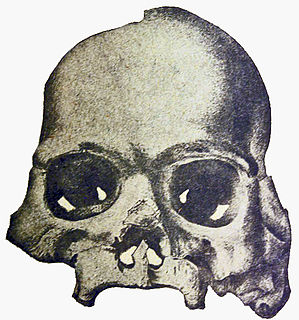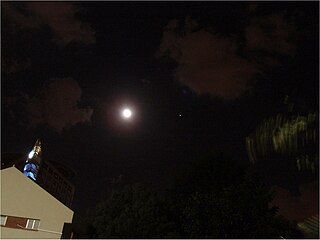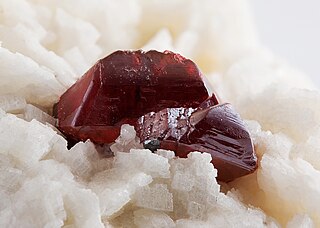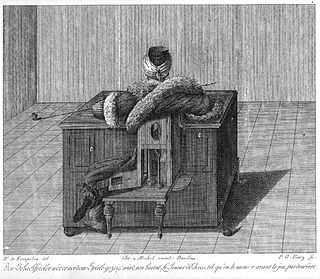 W
WThe alien autopsy is a 17-minute black-and-white film supposedly depicting a secret medical examination or autopsy of an alien by the United States military. It was released in 1995 by London-based entrepreneur Ray Santilli. He presented it as an authentic autopsy on the body of an alien recovered from the 1947 crash of a "flying disc" near Roswell, New Mexico. The film footage was allegedly supplied to him by a retired military cameraman who wished to remain anonymous.
 W
W"Archaeoraptor" is the informal generic name for a fossil chimera from China in an article published in National Geographic magazine in 1999. The magazine claimed that the fossil was a "missing link" between birds and terrestrial theropod dinosaurs. Even prior to this publication there had been severe doubts about the fossil's authenticity. Further scientific study showed it to be a forgery constructed from rearranged pieces of real fossils from different species. Zhou et al. found that the head and upper body actually belong to a specimen of the primitive fossil bird Yanornis. A 2002 study found that the tail belongs to a small winged dromaeosaur, Microraptor, named in 2000. The legs and feet belong to an as yet unknown animal.
 W
WBeringer's Lying Stones (Lügensteine) are pieces of limestone which were carved into the shape of various fictitious animals and "discovered" in 1725 by Professor Johann Bartholomeus Adam Beringer (1667-1740), Dean of the Faculty of Medicine at the University of Würzburg. Beringer believed them to be fossils, and because some of them bore the name of God in Hebrew, suggested that they might be of divine origin. He published a book on his findings but shortly after discovered that he had been the victim of a hoax. He took the hoaxers to court and won the case but his reputation was forever besmirched.
 W
WThe Bogdanov affair was an academic dispute regarding the legitimacy of a series of theoretical physics papers written by French twins Igor and Grichka Bogdanov. These papers were published in reputable scientific journals, and were alleged by their authors to culminate in a proposed theory for describing what occurred at and before the Big Bang.
 W
WPeter Gregory Boghossian is an American philosopher and pedagogist. Born in Boston, he was an assistant professor of philosophy at Portland State University for ten years, and his areas of academic focus include atheism, critical thinking, pedagogy, scientific skepticism, and the Socratic method. He is the author of A Manual for Creating Atheists and How to Have Impossible Conversations: A Very Practical Guide.
 W
WThe Calaveras Skull was a human skull found by miners in Calaveras County, California, which was purported to prove that humans, mastodons, and mammoths had coexisted in California. It was later revealed to be a hoax. Coincidentally, "calaveras" is the Spanish word for "skulls".
 W
WLegrand G. Capers was an American physician, best known for his 1874 spurious case report of bullet-mediated impregnation of a young woman.
 W
WThe Cardiff Giant was one of the most famous hoaxes in American history. It was a 10-foot-tall (3.0 m) purported "petrified man" uncovered on October 16, 1869, by workers digging a well behind the barn of William C. "Stub" Newell in Cardiff, New York. Both it and an unauthorized copy made by P. T. Barnum are still being displayed. The original is currently on display at The Farmers' Museum in Cooperstown, New York.
 W
WThe disappearing blonde gene was a hoax about how a scientific study had estimated that natural blonds would become extinct, repeated as fact in reputable media such as the BBC and The Sunday Times between 2002 and 2006. Claims that blond hair would disappear have been made since 1865.
 W
WEnigmarelle was a fake humanoid automaton, in fact with a person concealed inside, which was exhibited as a scientific and technical curiosity around 1905 in the US and Europe, chiefly in theaters. Enigmarelle was claimed to be able to perform several extraordinary tasks, which it demonstrated in performances: these included walking, riding a bicycle, and writing its name on a blackboard.
 W
WThe fur-bearing trout is a legendary creature purportedly found in American folklore and Icelandic folklore. According to folklore, the trout has created a thick coat of fur to maintain its body heat. Tales of furry fish date to the 17th-century and later the "shaggy trout" of Iceland. The earliest known American publication dates from a 1929 Montana Wildlife magazine article by J.H. Hicken. A taxidermy furry trout produced by Ross C. Jobe is a specimen at the Royal Museum of Scotland; it is a trout with white rabbit fur "ingeniously" attached.
 W
WThe grievance studies affair, also referred to as the "Sokal Squared" scandal, was the project of a team of three authors—Peter Boghossian, James A. Lindsay, and Helen Pluckrose—to highlight what they saw as poor scholarship and eroding criteria in several academic fields. Taking place over 2017 and 2018, their project entailed submitting bogus papers to academic journals in cultural, queer, race, gender, fat, and sexuality studies to determine whether they would pass through peer review and be accepted for publication. Several of these papers were subsequently published, which the authors cited in support of their contention.
 W
WThe Hastings Rarities affair is a case of statistically demonstrated ornithological fraud that misled the bird world for decades in the 20th century. The discovery of the long-running hoax shocked ornithologists.
 W
WThe Huemul Project was an early 1950s Argentine effort to develop a fusion power device known as the Thermotron. The concept was invented by Austrian scientist Ronald Richter, who claimed to have a design that would produce effectively unlimited power.
 W
WThe Kensington Runestone is a 202-pound (92 kg) slab of greywacke stone covered in runes that was allegedly discovered in central Minnesota in 1898. Olof Öhman, a Swedish immigrant, reported that he unearthed it from a field in the largely rural township of Solem in Douglas County. It was later named after the nearest settlement, Kensington.
 W
WThe Mars hoax was a hoax circulated by e-mail that began in 2003, that claimed that Mars would look as large as the full Moon to the naked eye on August 27, 2003. The hoax has since resurfaced each time before Mars is at its closest to Earth, about every 22 months. It began from a misinterpretation and exaggeration of a sentence in an e-mail message that reported the close approach between Mars and the Earth in August 2003. At that time, the distance between the two planets was about 55,758,000 kilometres (34,646,000 mi), which was the closest distance between them since September 24, 57,617 BC, when the distance has been calculated to have been about 55,718,000 kilometres (34,622,000 mi).
 W
WOmpax spatuloides was a hoax fish "discovered" in Australia in August, 1872. Said to be poisonous, it could be found on some lists of Australian fishes through the 1930s.
 W
WOrgueil is a scientifically important carbonaceous chondrite meteorite that fell in southwestern France in 1864.
 W
WThe Pacific Northwest tree octopus is an Internet hoax created in 1998 by a humor writer under the pseudonym Lyle Zapato. This fictitious endangered species of cephalopod was given the Latin name Octopus paxarbolis. It was purportedly able to live both on land and in water, and was said to live in the Olympic National Forest and nearby rivers, spawning in water where its eggs are laid. Its major predator was said to be the Sasquatch. Since its creation, the Pacific Northwest tree octopus website has been commonly referenced in Internet literacy classes in schools and has been used in multiple studies demonstrating children's gullibility regarding online sources of information.
 W
WPamiętnik handlowca is the name of a purported diary written by a Polish merchant, Zbigniew Stefański, in 1625. No copy of the original text is known to exist. The diary was said to be written in Old Polish and to contain a first-hand account of the Jamestown Colony in Virginia. It was claimed to be the only extant primary source from the Jamestown Colony that provides the perspective of Polish artisans who had been brought in by Captain John Smith in 1608. As the existence of the diary has been confirmed by only a single researcher, its veracity and very existence have been questioned.
 W
WRed mercury is purportedly a substance of uncertain composition used in the creation of nuclear weapons, as well as other weapons systems. Because of the great secrecy surrounding the development and manufacturing of nuclear weapons, there is no proof that red mercury exists. However, all samples of alleged "red mercury" analyzed in the public literature have proven to be well-known, common red substances of no interest to weapons makers.
 W
WCharles Redheffer was an American inventor who claimed to have invented a perpetual motion machine. First appearing in Philadelphia, Redheffer exhibited his machine to the public, charging high prices for viewing. When he applied to the government for more money, a group of inspectors were sent to examine the machine. It was discovered the machine was actually powered by a device Redheffer claimed was powered by the machine.
 W
WThe skvader is a Swedish fictional creature that was constructed in 1918 by the taxidermist Rudolf Granberg and is permanently displayed at the museum at Norra Berget in Sundsvall. It has the forequarters and hindlegs of a European hare, and the back, wings and tail of a female wood grouse. It was later jokingly given the Latin name Tetrao lepus pseudo-hybridus rarissimus L.
 W
WSong Yoo-geun is a South Korean person who gained recognition as a child prodigy in South Korea since 2004. After graduating college in 2009, he was involved in a number of controversies during his ultimately unsuccessful doctorate program at Korean University of Science and Technology (UST), including one involving his paper in October 2015 written with his advisor, Park Seok-jae. The paper, entitled "Axisymmetric, Nonstationary Black Hole Magnetospheres: Revisited" appeared in the Astrophysical Journal (ApJ). However, the paper was soon retracted due to concerns that it plagiarized a 2002 book chapter.
 W
WThe Turk, also known as the Mechanical Turk or Automaton Chess Player, was a fake chess-playing machine constructed in the late 18th century. From 1770 until its destruction by fire in 1854 it was exhibited by various owners as an automaton, though it was eventually revealed to be an elaborate hoax. Constructed and unveiled in 1770 by Wolfgang von Kempelen (1734–1804) to impress Empress Maria Theresa of Austria, the mechanism appeared to be able to play a strong game of chess against a human opponent, as well as perform the knight's tour, a puzzle that requires the player to move a knight to occupy every square of a chessboard exactly once.
 W
WThe Villejuif leaflet, also known as the Villejuif flyer and the Villejuif list, was a pamphlet which enjoyed wide distribution. The leaflet listed a number of safe food additives with their E numbers as alleged carcinogens. The leaflet caused mass panic in Europe in the late 1970s and 1980s. One of the entries on the list was citric acid (E330).